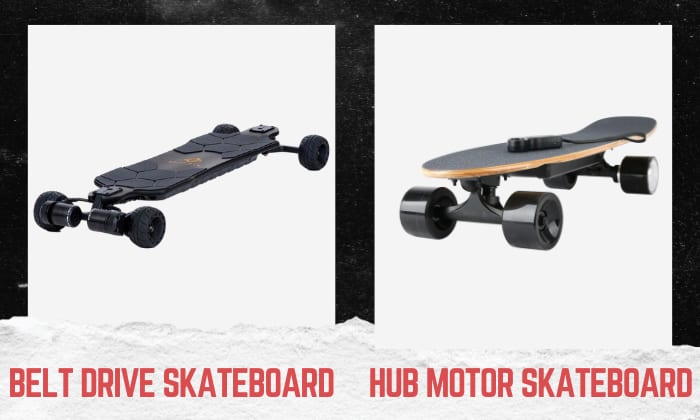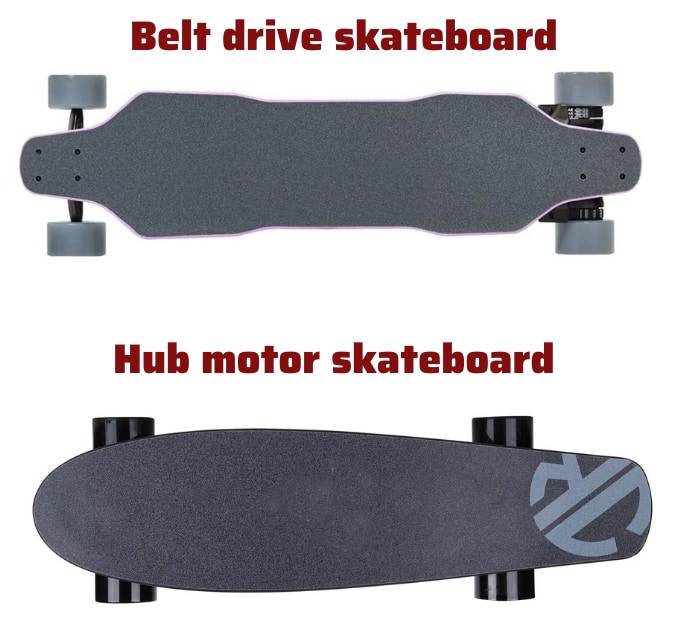Before skateboards entered the competition arena, they served as a mode of transportation among the early skaters.
But not too long after they started to become popular, several brands designed e-skateboards, a more convenient way to commute on a skateboard.
Like the regular ones, e-skates also vary in significant aspects, specifically the motors. So, today, we will learn about the belt drive VS hub motor electric skateboard. These are the most popular types of electric skateboards systems today.
This article will show us more than their differences. We will see how each works and what’s better overall.
| Criteria | Belt drive skateboard | Hub motor skateboard |
| Noise | Bolder design, thus noisier | Makes minimal noise |
| Braking | More powerful brakes | Perfect for smooth, gradual stops |
| Hill-climb | More torque means more force to climb uphill | Moves uphill but not as powerful as belt-driven boards |
| Acceleration | Has gears to spike up acceleration | Slower acceleration |
| Maintenance | Challenging to maintain because of parts exposed to outer elements | Requires moderate maintenance because of the wheel enclosure |
| Overall performance | More torque but shorter range | Can be pushed when out of power, longer battery life |
Table of Contents
What Are Belt Drive and Hub Motors?
Both belt drive and hub motors yield exceptional speed and power. But before choosing one, we should know everything about them.
- Belt drive electric skateboard
Perhaps, you already visualized what a belt-driven e-skateboard looks like by its name alone. Yes, boards installed with a belt drive motor have physical straps.
Belt-driven e-skateboards have separate motor attachments to the deck, like a set of mini engines assigned to each wheel. Each motor has a geared side, and so do the rollers. These gears sit in parallel positions, bound by a rubber belt.
That means once the motors operate and rotate, the belt moves and translates the rotations to the wheels. And that’s what makes this skateboard move.
- Hub motor skateboard
Electric skateboards operating with a hub motor have no belt in their system. So, what mechanism makes them work?
The motors of a hub-drive skateboard are the wheels themselves. But how? Unlike the belt-driven e-skate, this type has its electric skateboard motor in wheel cases.
So, it’s the motors spinning the wheels directly in this setup. No other mechanisms transfer energy from the mini engines to the rollers.
Differences Between Hub Motor and Belt Drive Skateboards
Hub and belt skateboards yield the same goal. But this time, let’s see how these motors differ in the following aspects.
1. Noise
If we get annoyed by car and motorcycle noise, we might as well consider that an electric longboard motor could also make disturbing sounds, given they operate using an engine-like mechanism. But between the belt and hub drive, which one makes more noise?
In this aspect, hub motors win by being the quieter ones. Based on the designs of a belt drive skateboard, the engines and belt sit outside the wheels. On the other hand, hub drives are covered by the wheels’ rubber, so the noise has to pass through this material first.
2. Braking
The more speed a skateboard has, the better safety we need. Both skateboard types have braking features.
However, a belt driven electric longboard has more powerful brakes, so powerful that you may find the stop quite abrupt. Hub motors are more gradual when slowing down.
So, if you are a skater that rides in traffic a lot, belt-driven motors may be better. But if you do not need to stop quickly and can anticipate vehicles and other people before they approach, hub e-skateboards are the way to go.
3. Hill climbs
Can electric skateboards climb uphill? Absolutely! But are there limitations?
Where there are elevations in the trail, belt drive motors excel more. How? The force on these skateboard engines is stronger than their hub counterpart. Nonetheless, it’s not much of a difference, so hub-driven skateboard motors can still catch up.
4. Acceleration
Had safety not been a constraint, every skater would want their boards to accelerate as fast as possible.
Between hub and belt drive skateboards, the latter wins this aspect. Belt drive motors accelerate faster because of their gears and overall design. This motor for electric skateboard allows you to complete trips quicker if you’re in a rush.
5. Maintenance
It may sound like added work, but e-skateboards require more maintenance than regular boards. So, between hub and belt drive e-skates, is one more challenging to maintain? Let’s talk about both types.
Belt drive e-skates have their motors and belts exposed. In other words, dust, dirt, and other particles are more likely to contact their system.
On the other hand, hub motor skateboards have their systems enclosed. That means their overall function remains safe against these elements.
If there’s one area in maintenance that favors belt drive motors more, it’s the fact that their parts are individually replaceable, unlike the hub, which requires changing the entire system.
6. Overall performance
When the skateboard runs out of power, which motor can you push? It’s the hub motor kit.
But besides this saddening event, one thing that gives hub motor skateboards an edge is the truth that their mini engines have lower rolling resistance. Hence, these e-skateboards are easier to push and require less energy to run.
In terms of range, the hub motors still have it. Why? It has a more efficient design. And notwithstanding the skater’s weight, these skateboards have a more extensive range and battery life.
7. Prices
Of course, the budget remains a constraint, especially since these boards are electronic. Here are a few products to help you compare today’s hub and belt e-skateboard prices.
Belt drive skateboards
- WowGo 3X Electric Skateboard & Longboard – $499.99
- Meepo Voyager – $999.00
- Endeavor1 S – $999.00
Hub motor skateboards
- HOLYWAY Electric Skateboard – $159.99
- SIFLIF Electric Skateboard – $179.99
- EXWAY Wave Hub Electric Skateboard – $699.00
Pros and cons
Let us highlight the best and not-so-desirable things about belt and hub motor e-skateboards.
Belt drive skateboard
- Better torque
- Releases heat better
- Flexible wheel selection
- More maintenance is necessary due to exposure to the elements.
- Shorter battery life
- More noise than hub motors
Hub motor skateboard
- Better battery life
- Longer skating range
- Less friction for easier pushing when out of battery
- Less noise
- No drive gear size adjustment for improved torque
- More heat trapped
- Challenging to replace wheels
Which is Better, the Hub Motor or the Belt Drive?
Both e-skateboard types exhibit exceptional features that give them advantages over the other. That means it’s a matter of priority when we choose between a belt drive kit and hub motor boards.
As mentioned, hub motor e-boards are quieter because of their enclosed design. And for a skater who prefers smooth, calming rides, hub-driven boards are the key.
For design reasons, the hub motor boards fit users who love their e-skates straightforwardly, with no dangling belts under the deck. Also, this style requires minimal maintenance because it is less vulnerable to external elements.
Ultimately, what most skateboard users love about hub drive boards is how they remain functional even after running out of power.
On the other hand, belt drive boards are your best buddies if you want exceptional torque and power. This e-skate type allows you to multiply your motor’s force and yield dominant rides. They could be noisy, but that does not seem like an issue for many.
Conclusion
Electric skateboards have long become a part of the skateboarding community. While their build, speed, cost, and performance create a significant gap from regular boards, we can’t deny how they yield noticeable benefits.
Now that we know the differences between a belt drive VS hub motor electric skateboard, choosing the suitable wheel system is finally easier. We already knew how the belt surpasses the hub in one aspect and vice versa.
Again, it’s a matter of priority. Both motor types are advantageous. Belt drives are powerful, while hub motors are neat and sleek.

Hi, I am Charles Harris. I opened this site to write as much as I can about my biggest passion – skateboarding!
I started as a clumsy yet passionate rookie 10 years ago to now a still passionate yet much better skateboarder! But I have to tell you, the whole journey has always been fun and rewarding, indeed not without hardship.





